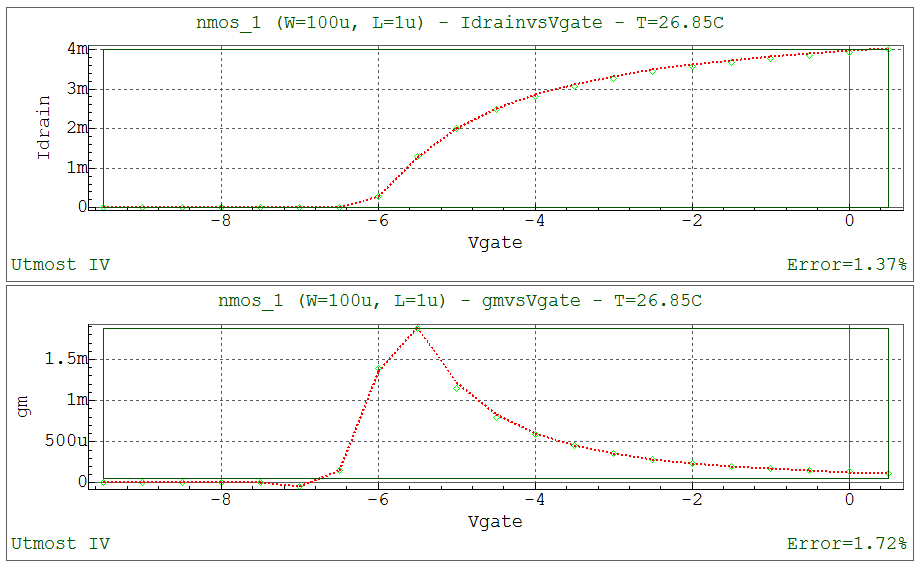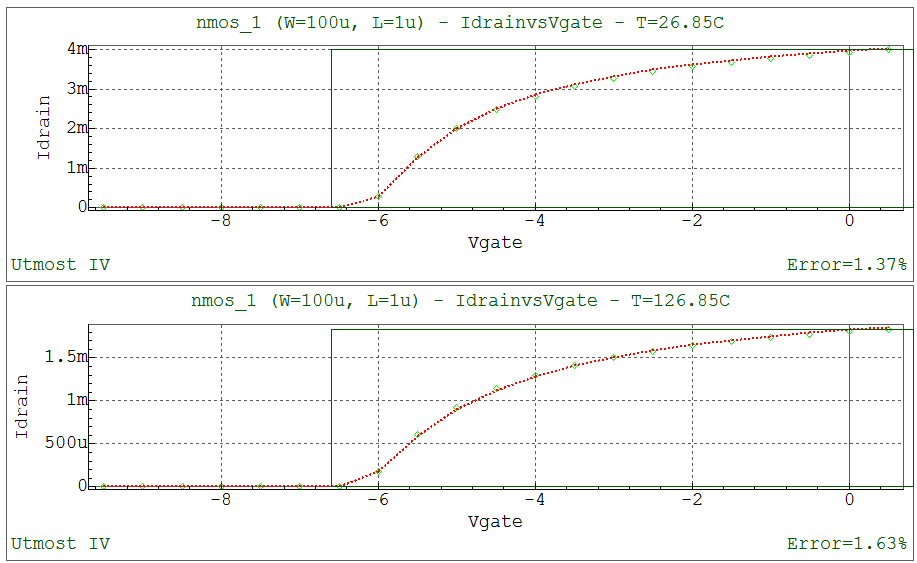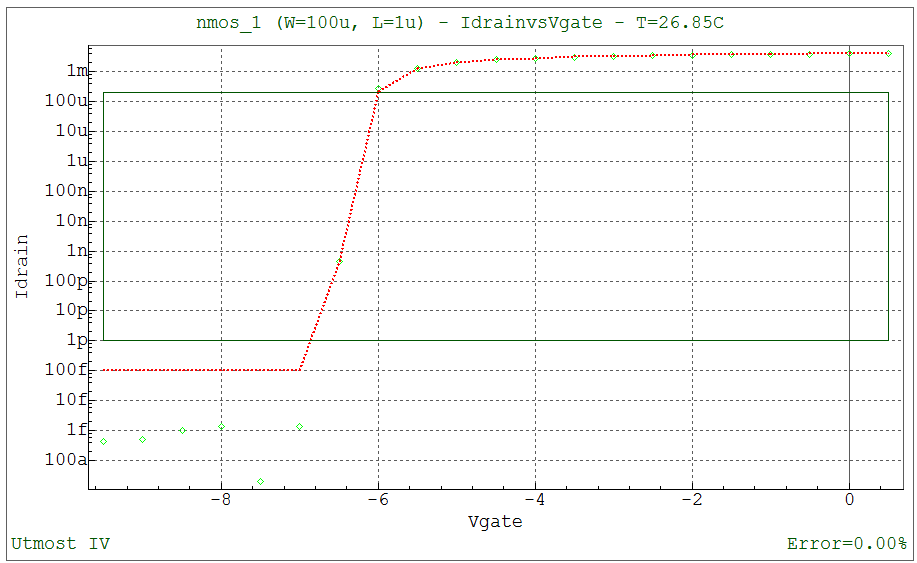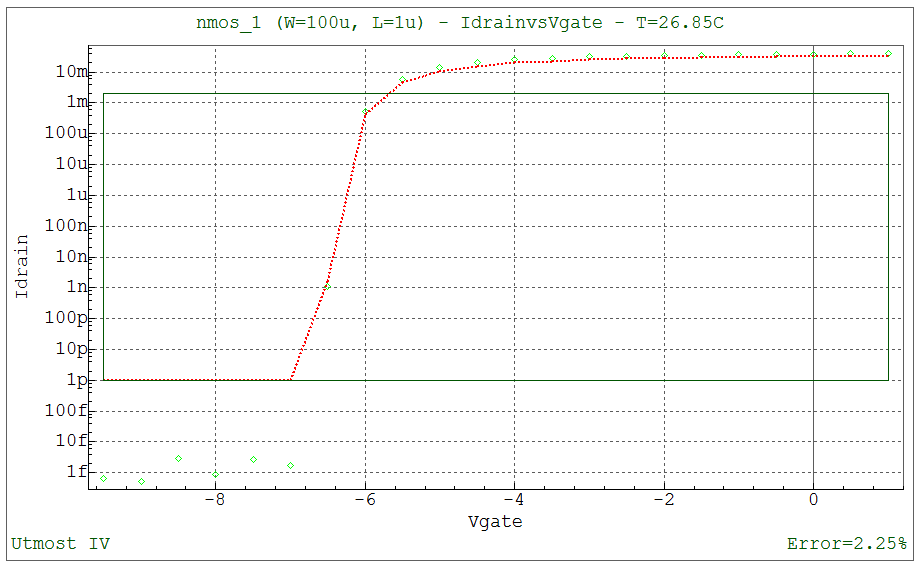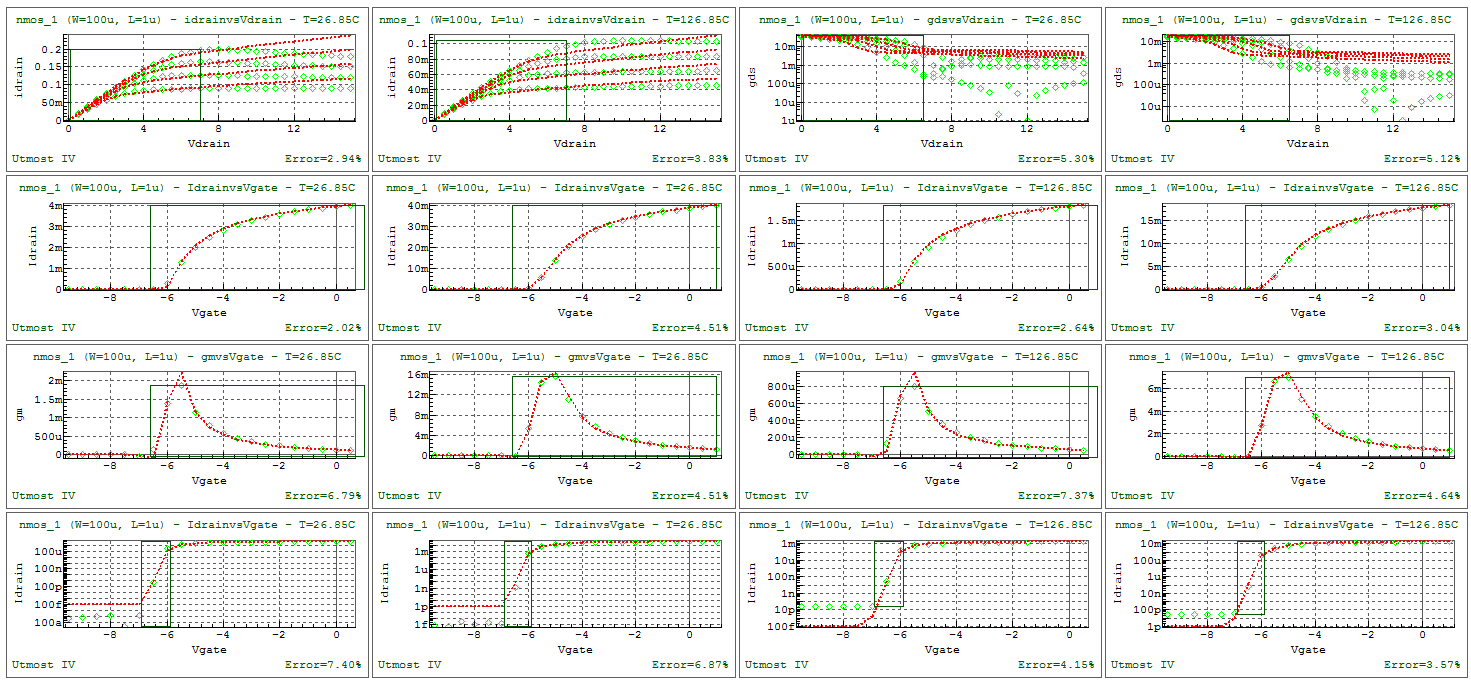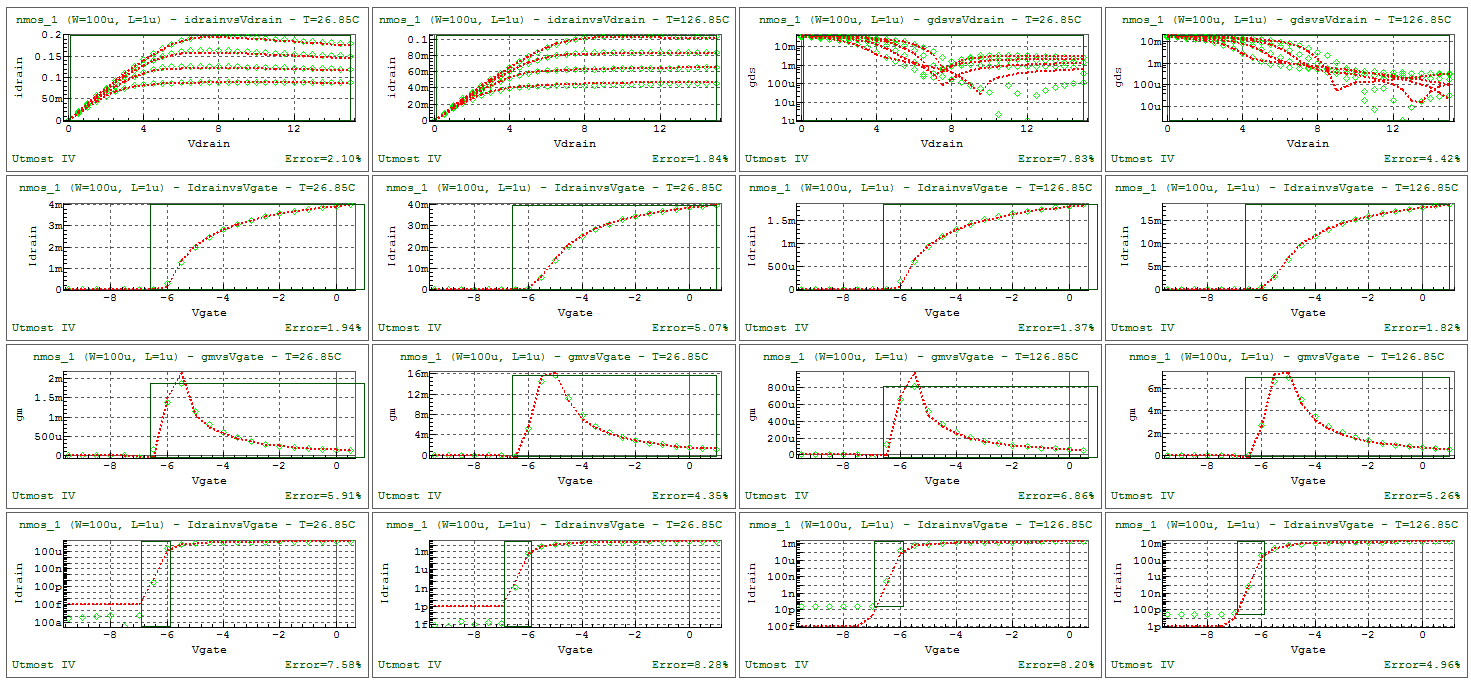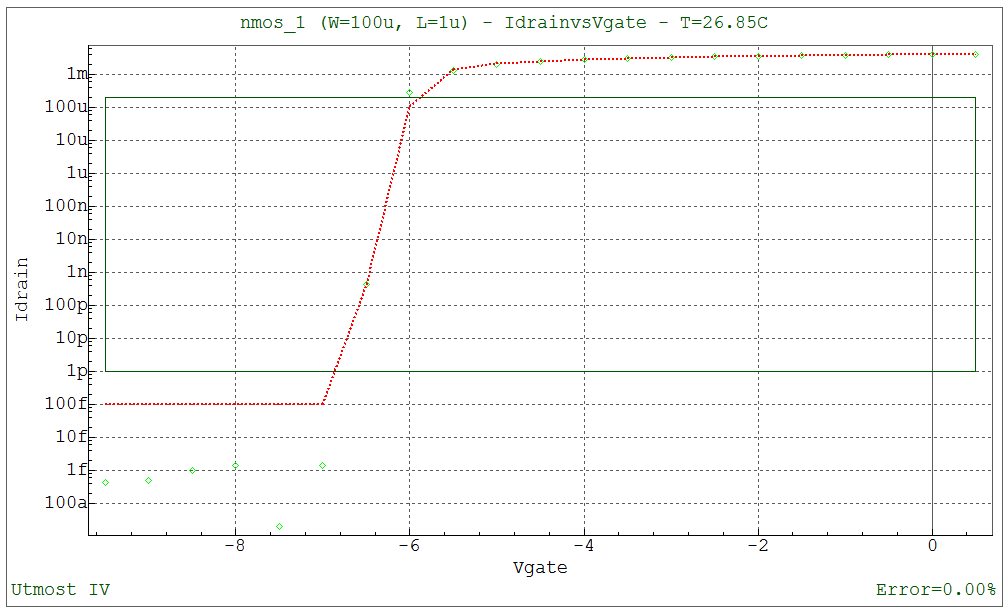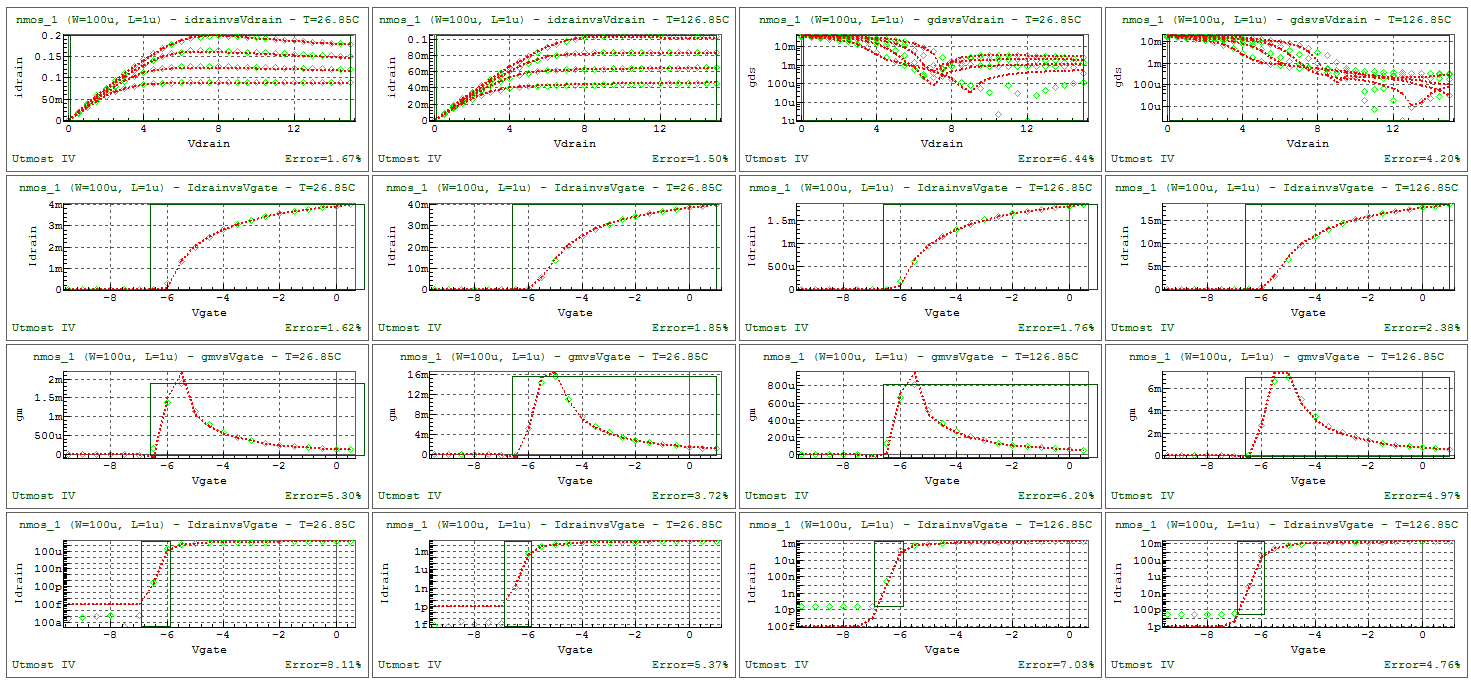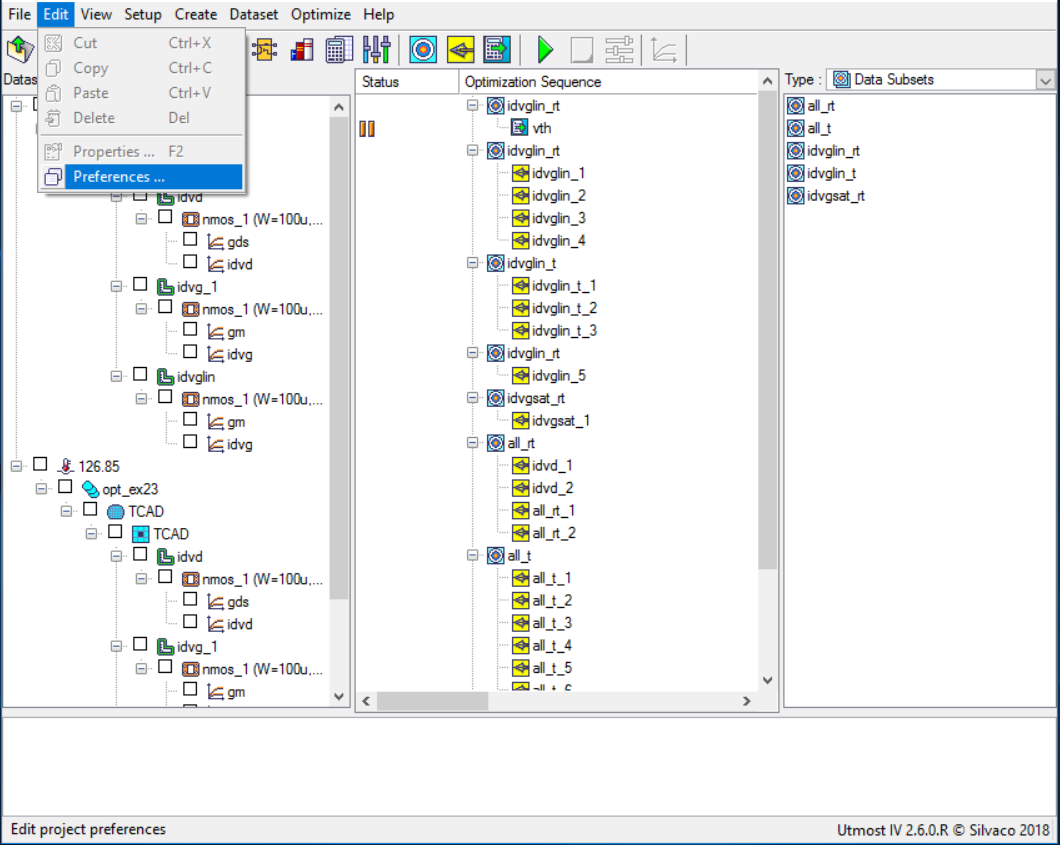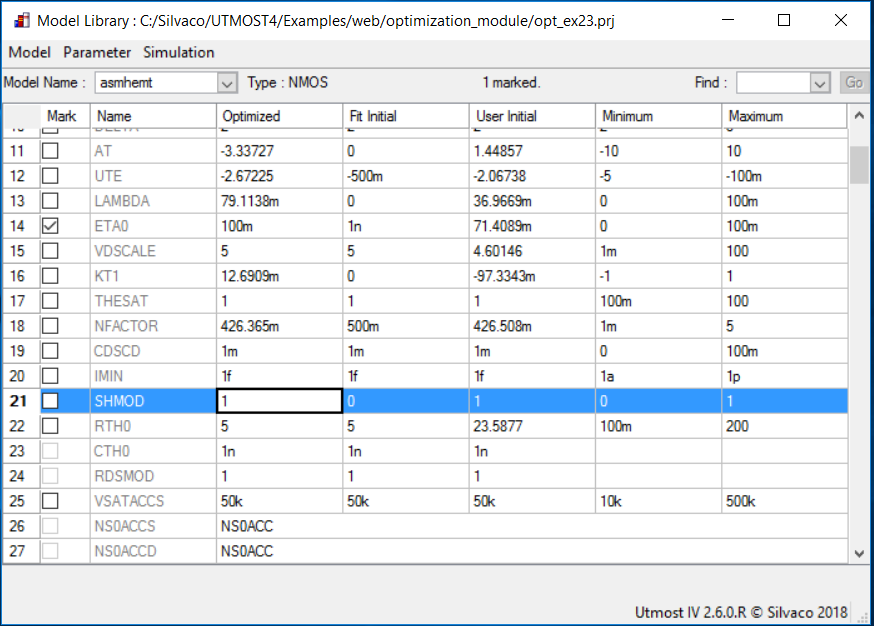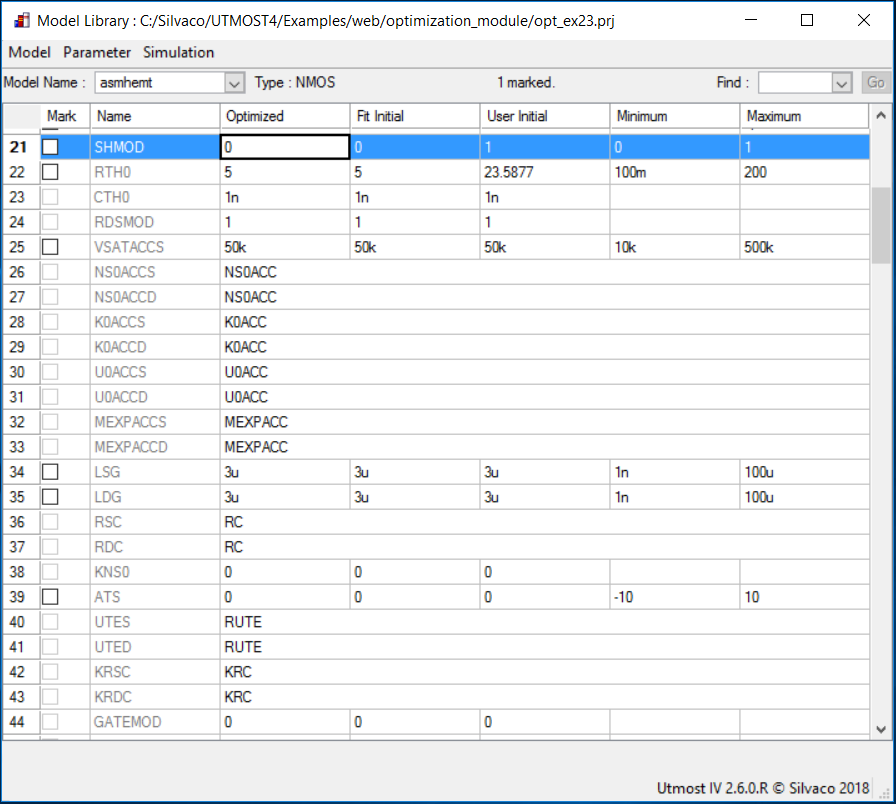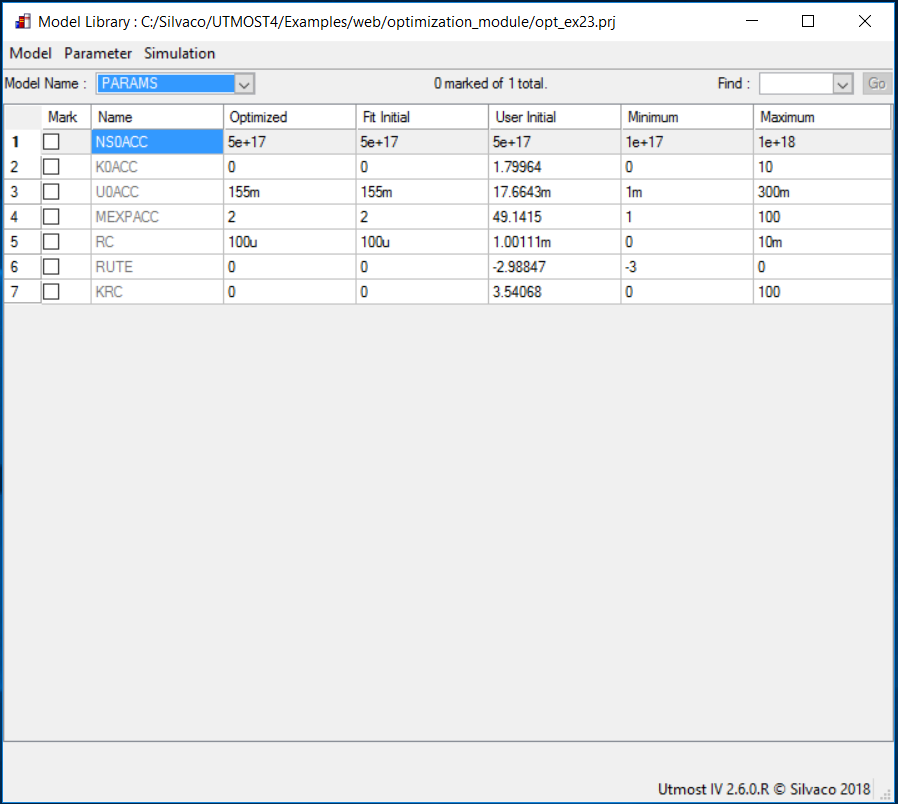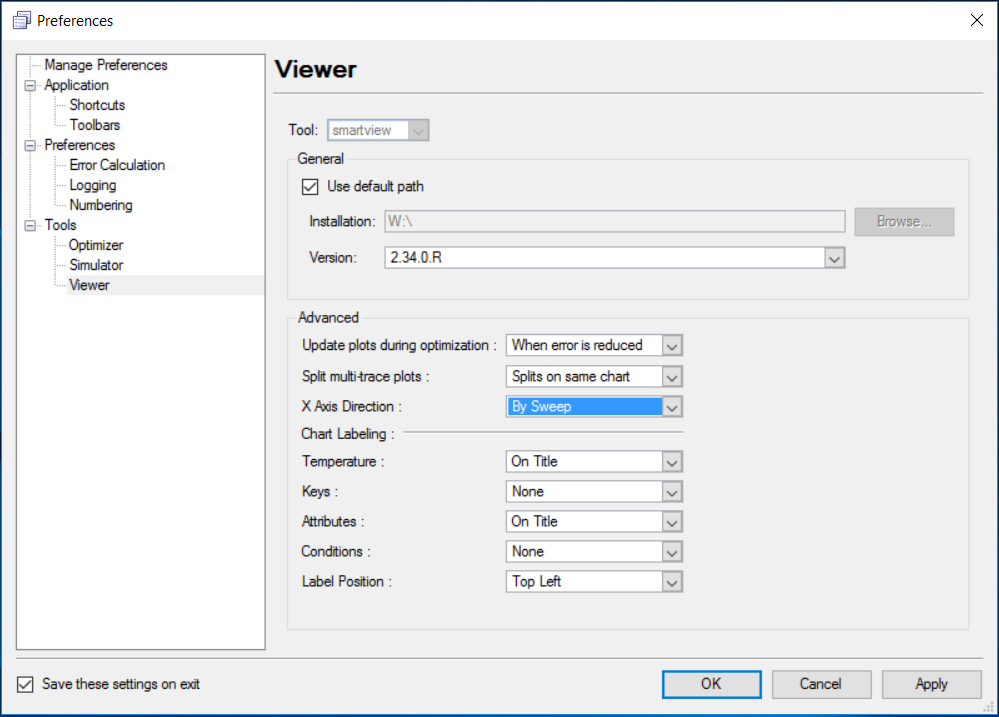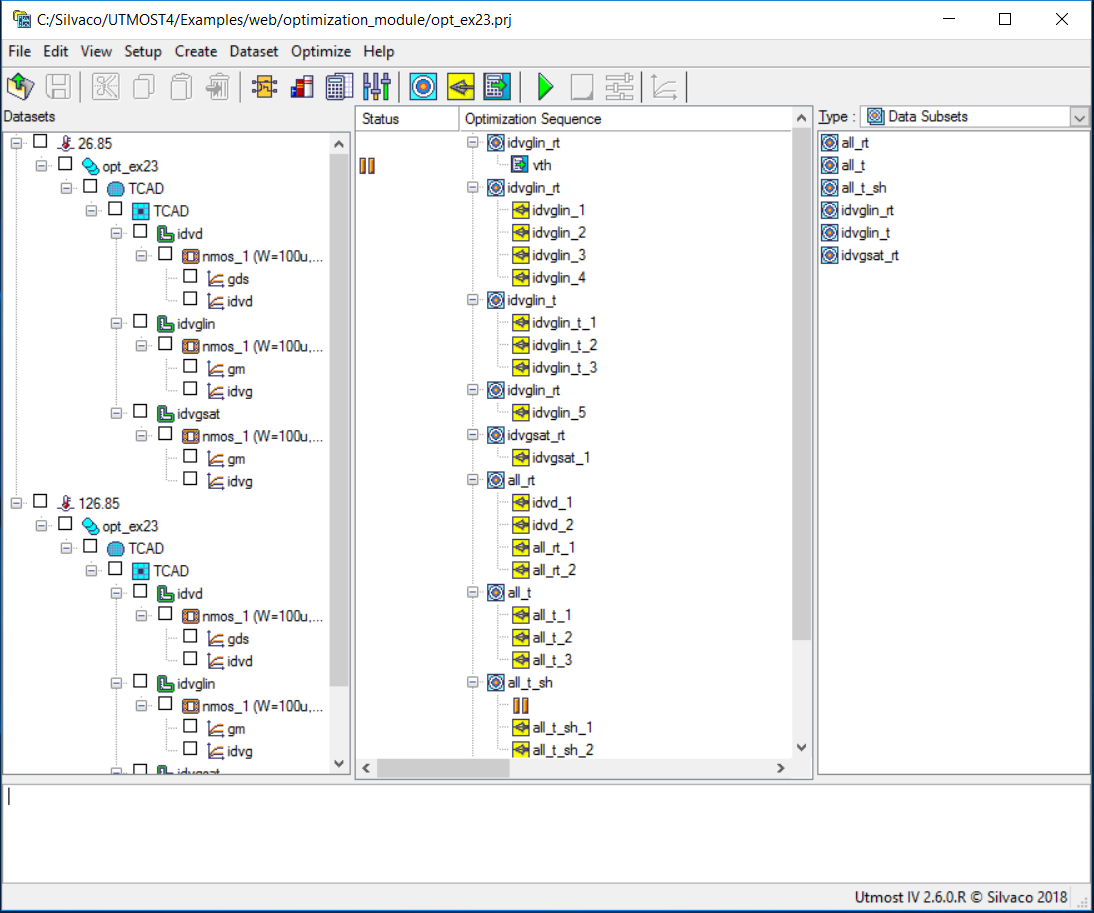opt_ex23 : ASM-HEMT Symmetric GaN HEMT Model Extraction
Requires: Utmost IV, SmartSpice, SmartView
Minimum Versions: Utmost IV 2.4.0.R, SmartSpice 4.32.0.R, SmartView 2.34.0.R.
This example describes how to extract an ASM model using a single geometry, symmetric HEMT device.
The project file opt_ex23.prj and the data file opt_ex23.uds for this example should be loaded into your database. When opened, the project will look as shown in opt_ex23_project.png .
Preliminary information
The ASM model allows independent parameters to describe the source and drain region resistances and their bias dependencies. In order to consider symmetric devices with the same parameter values for drain and source, respectively, one can assign two model parameters to the same netlist parameter and optimize the netlist parameter instead: opt_ex23_model_card.png and opt_ex23_netlist_parameters.png .
Note that the self-heating model is disabled for the first 7 steps. This is done by setting the SHMOD model parameter to 0: opt_ex23_model_card.png . The self-heating model will be turned on at the beginning of Section 8.
This example uses depletion mode HEMT devices. In order to better display the ID-VG plots of such devices, one needs to edit the preferences: opt_ex23_edit_preferences.png and set the X Axis Direction to "By Sweep" in the Viewer preferences: opt_ex23_preferences_x_axis.png .
The optimization sequence, which automates the parameter extraction, is divided into nine sections. The objective of each section is to isolate a device characteristic and then to optimize only those model parameters which account for this device behavior. Some model parameters are optimized in multiple sections for better fitting.
Before starting the optimization sequence, the following device parameters are defined in the model library.
- TBAR: Thickness of the AlGaN Layer
- LDG: Drain side access region distance
- LSG: Source side access region distance
- TNOM: Nominal (room) temperature
Section 1 : idvglin_rt
This section performs a preliminary extraction of the threshold voltage for the wide and long channel device, using the drain current versus gate voltage characteristic in the linear region and at room temperature. The extracted value is stored in the VOFF model parameter, as shown in opt_ex23_01.png .
Section 2 : idvglin_rt
This section optimizes the parameters for wide and long channel devices. The data in this section is the drain current versus gate voltage characteristic in the linear region and at room temperature. The following model parameters are extracted.
- VOFF Cut-off voltage
- NFACTOR Subthreshold slope
- U0 Low-field mobility
- UA Mobility degradation coefficient
- RSC Source contact resistance (uses the value of netlist parameter RC)
- RDC Drain contact resistance (uses the value of netlist parameter RC)
After this step has been completed, the fit to measured data will be as shown in opt_ex23_02.png .
Section 3: idvglin_t
This section extracts the model parameters for the large geometry drain current versus gate voltage linear temperature measurements. The following parameters are optimized.
- KT1 Voff dependence on temperature
- UTE Mobility temperature dependence
- KRSC Rsc temperature dependence (uses the value of netlist parameter KRC)
- KRDC Rdc temperature dependence (uses the value of netlist parameter KRC)
After this step has been completed, the fit to measured data will be as shown in opt_ex23_03.png .
Section 4: idvglin_rt
This section is used for refining the value of the subthreshold slope parameter.
- NFACTOR Subthreshold slope
After this step has been completed, the fit to measured data will be as shown in opt_ex23_04.png .
Section 5 : idvgsat_rt
The first 4 sections concentrated only on the linear regions drain current versus gate voltage for each of the different geometries. This section will use the high VDS subthreshold drain current versus gate voltage data for multiple lengths. The following parameters are optimized.
- ETA0 DIBL coefficient
After this step has been completed, the fit to measured data will be as shown in opt_ex23_05.png .
Section 6 : all_rt
This section uses room temperature data from all operating regions. The following parameters are optimized and refined.
- VSAT Saturation velocity
- LAMBDA Channel length modulation parameter
- ETA0 DIBL coefficient
- VOFF Cut-off voltage
- NFACTOR Subthreshold slope
- U0 Low-field mobility
- UA Mobility degradation coefficient
- RSC Source contact resistance (uses the value of netlist parameter RC)
- RDC Drain contact resistance (uses the value of netlist parameter RC)
After this step has been completed, the fit to measured data will be as shown in opt_ex23_06.png .
Section 7 : all_t
This section combines all temperature data to optimize the access region specific model parameters and to refine all previously extracted model parameters.
- K0ACCS Source access region charge Vgs dependence (uses netlist parameter K0ACC)
- K0ACCD Drain access region charge Vgs dependence (uses netlist parameter K0ACC)
- MEXPACCS Source access region resistance exponent (uses netlist parameter MEXPACC)
- MEXPACCD Drain access region resistance exponent (uses netlist parameter MEXPACC)
- U0ACCS Source access region mobility (uses netlist parameter U0ACC)
- U0ACCD Drain access region mobility (uses netlist parameter U0ACC)
- UTES Source access region mobility temperature dependence (uses netlist parameter RUTE)
- UTED Source access region mobility temperature dependence (uses netlist parameter RUTE)
- AT Vsat dependence on temperature
- VSAT Saturation velocity
- LAMBDA Channel length modulation parameter
- ETA0 DIBL coefficient
- VOFF Cut-off voltage
- NFACTOR Subthreshold slope
- U0 Low-field mobility
- UA Mobility degradation coefficient
- RSC Source contact resistance (uses netlist parameter RC)
- RDC Drain contact resistance (uses netlist parameter RC)
- KT1 Voff dependence on temperature
- UTE Mobility temperature dependence
- KRSC Rsc temperature dependence (uses netlist parameter KRC)
- KRDC Rdc temperature dependence (uses netlist parameter KRC)
After this step has been completed, the fit to measured data will be as shown in opt_ex23_07.png .
Section 8 : all_t_sh
Note: Before running this section, the self-heating model must be enabled. This is done by setting the SHMOD parameter to 1, as shown in opt_ex23_enable_shmod.png .
This section combines all temperature data to refine all previously extracted model parameters, including the temperature coefficients and the thermal resistance:
- K0ACCS Source access region charge Vgs dependence (uses netlist parameter K0ACC)
- K0ACCD Drain access region charge Vgs dependence (uses netlist parameter K0ACC)
- MEXPACCS Source access region resistance exponent (uses netlist parameter MEXPACC)
- MEXPACCD Drain access region resistance exponent (uses netlist parameter MEXPACC)
- U0ACCS Source access region mobility (uses netlist parameter U0ACC)
- U0ACCD Drain access region mobility (uses netlist parameter U0ACC)
- UTES Source access region mobility temperature dependence (uses netlist parameter RUTE)
- UTED Source access region mobility temperature dependence (uses netlist parameter RUTE)
- AT Vsat dependence on temperature
- VSAT Saturation velocity
- LAMBDA Channel length modulation parameter
- ETA0 DIBL coefficient
- RTH0 Thermal resistance
- VOFF Cut-off voltage
- NFACTOR Subthreshold slope
- U0 Low-field mobility
- UA Mobility degradation coefficient
- RSC Source contact resistance (uses netlist parameter RC)
- RDC Drain contact resistance (uses netlist parameter RC)
- KT1 Voff dependence on temperature
- UTE Mobility temperature dependence
- KRSC Rsc temperature dependence (uses netlist parameter KRC)
- KRDC Rdc temperature dependence (uses netlist parameter KRC)
After this step has been completed, the fit to measured data will be as shown in opt_ex23_08.png .
Section 9: idvglin_rt
This section is used for again refining the value of the subthreshold slope parameter.
- NFACTOR Subthreshold slope
After this step has been completed, the fit to measured data will be as shown in opt_ex23_09.png .
Section 10 : all_t_sh
This section combines all temperature data to refine all previously extracted model parameters while adding a few more in order to improve accuracy:
- K0ACCS Source access region charge Vgs dependence (uses netlist parameter K0ACC)
- K0ACCD Drain access region charge Vgs dependence (uses netlist parameter K0ACC)
- MEXPACCS Source access region resistance exponent (uses netlist parameter MEXPACC)
- MEXPACCD Drain access region resistance exponent (uses netlist parameter MEXPACC)
- U0ACCS Source access region mobility (uses netlist parameter U0ACC)
- U0ACCD Drain access region mobility (uses netlist parameter U0ACC)
- UTES Source access region mobility temperature dependence (uses netlist parameter RUTE)
- UTED Source access region mobility temperature dependence (uses netlist parameter RUTE)
- VSATACCS Access region saturation velocity
- AT Vsat dependence on temperature
- VDSCALE DIBL Vds scaling
- VSAT Saturation velocity
- LAMBDA Channel length modulation parameter
- ETA0 DIBL coefficient
- RTH0 Thermal resistance
- VOFF Cut-off voltage
- NFACTOR Subthreshold slope
- U0 Low-field mobility
- UA Mobility degradation coefficient
- RSC Source contact resistance (uses netlist parameter RC)
- RDC Drain contact resistance (uses netlist parameter RC)
- KT1 Voff dependence on temperature
- UTE Mobility temperature dependence
- KRSC Rsc temperature dependence (uses netlist parameter KRC)
- KRDC Rdc temperature dependence (uses netlist parameter KRC)
After this step has been completed, the fit to measured data will be as shown in opt_ex23_10.png .
When complete, the model card and the netlist parameters can be exported into an external model library file as shown in the output file opt_ex23.lib.
opt_ex23.lib
.PARAM NS0ACC = 5e+17 .PARAM K0ACC = 1.79964 .PARAM U0ACC = 0.0176643 .PARAM MEXPACC = 49.1415 .PARAM RC = 0.00100111 .PARAM RUTE = -2.98847 .PARAM KRC = 3.54068 .MODEL asmhemt NMOS ( +LEVEL = 90 TNOM = 26.85 TBAR = 2.5e-08 +EPSILON = 1.066e-10 VOFF = -5.90052 U0 = 0.318433 +UA = 0 UB = 0 VSAT = 656843 +DELTA = 2 AT = 1.44857 UTE = -2.06738 +LAMBDA = 0.0369669 ETA0 = 0.0714089 VDSCALE = 4.60146 +KT1 = -0.0973343 THESAT = 1 NFACTOR = 0.426508 +CDSCD = 0.001 IMIN = 1e-15 SHMOD = 1 +RTH0 = 23.5877 CTH0 = 1e-09 RDSMOD = 1 +VSATACCS = 50000 NS0ACCS = NS0ACC NS0ACCD = NS0ACC +K0ACCS = K0ACC K0ACCD = K0ACC U0ACCS = U0ACC +U0ACCD = U0ACC MEXPACCS = MEXPACC MEXPACCD = MEXPACC +LSG = 3e-06 LDG = 3e-06 RSC = RC +RDC = RC KNS0 = 0 ATS = 0 +UTES = RUTE UTED = RUTE KRSC = KRC +KRDC = KRC GATEMOD = 0 TRAPMOD = 0 +RTRAP3 = 1 CTRAP3 = 0.0001 VATRAP = 10 +WD = 0.016 VDLR1 = 2 VDLR2 = 20 +TALPHA = 1 VTB = 250 DELTAX = 0.01 +CDLAG = 1e-06 RDLAG = 1e+06 IDIO = 1 +ATRAPVOFF = 0.1 +BTRAPVOFF = 0.3 +ATRAPETA0 = 0 +BTRAPETA0 = 0.05 +ATRAPRS = 0.1 BTRAPRS = 0.6 ATRAPRD = 0.5 +BTRAPRD = 0.6 RTRAP1 = 1 RTRAP2 = 1 +CTRAP1 = 1e-05 CTRAP2 = 1e-06 A1 = 0.1 +VOFFTR = 1e-09 CDSCDTR = 1e-15 ETA0TR = 1e-15 +RONTR1 = 1e-12 RONTR2 = 1e-13 RONTR3 = 1e-13 +CGSO = 0 CGDO = 0 CDSO = 0 +CGDL = 0 VDSATCV = 100 CFG = 0 +CFD = 0 CJ0 = 0 VBI = 0.9 +KTVBI = 0 KTCFG = 0 MZ = 0.5 +AJ = 0.1 DJ = 1 ADOSI = 0 +BDOSI = 1 QM0I = 0.001 FNMOD = 0 +TNMOD = 0 NOIA = 1.5e-11 NOIB = 0 +NOIC = 0 EF = 1 TNSC = 1e+27 +ADOSFP1 = 0 ADOSFP2 = 0 ADOSFP3 = 0 +ADOSFP4 = 0 BDOSFP1 = 1 BDOSFP2 = 1 +BDOSFP3 = 1 BDOSFP4 = 1 CBDO = 0 +CBGO = 0 CBSO = 0 CDSCDFP1 = 0 +CDSCDFP2 = 0 CDSCDFP3 = 0 CDSCDFP4 = 0 +CFGD = 0 CFGD0 = 0 CFGDSM = 1e-24 +CFP1SCALE = 0 +CFP2SCALE = 0 +CFP3SCALE = 0 +CFP4SCALE = 0 +CSUBSCALE1 = 0 +CSUBSCALE2 = 0 +CSUBSCALE3 = 0 +CSUBSCALE4 = 0 +CSUBSCALEI = 0 +ETA0FP1 = 1e-09 ETA0FP2 = 1e-09 ETA0FP3 = 1e-09 +ETA0FP4 = 1e-09 FP1MOD = 0 FP2MOD = 0 +FP3MOD = 0 FP4MOD = 0 +GAMMA0FP1 = 2.12e-12 +GAMMA0FP2 = 2.12e-12 +GAMMA0FP3 = 2.12e-12 +GAMMA0FP4 = 2.12e-12 +GAMMA0I = 2.12e-12 +GAMMA1FP1 = 3.73e-12 +GAMMA1FP2 = 3.73e-12 +GAMMA1FP3 = 3.73e-12 +GAMMA1FP4 = 3.73e-12 +GAMMA1I = 3.73e-12 GDSMIN = 1e-12 IGDDIO = 1 +IGSDIO = 1 IMINFP1 = 1e-15 IMINFP2 = 1e-15 +IMINFP3 = 1e-15 IMINFP4 = 1e-15 KTCFGD = 0 +KTFP1 = 0.05 KTFP2 = 0.05 KTFP3 = 0.05 +KTFP4 = 0.05 KTGD = 0 KTGS = 0 +NFACTORFP1 = 0.5 +NFACTORFP2 = 0.5 +NFACTORFP3 = 0.5 +NFACTORFP4 = 0.5 +NJGD = 2.5 NJGS = 2.5 QM0FP1 = 0.001 +QM0FP2 = 0.001 QM0FP3 = 0.001 QM0FP4 = 0.001 +RGATEMOD = 0 RSHG = 0.001 U0FP1 = 0.1 +U0FP2 = 0.1 U0FP3 = 0.1 U0FP4 = 0.1 +VDSCALEFP1 = 10 +VDSCALEFP2 = 10 +VDSCALEFP3 = 10 +VDSCALEFP4 = 10 +VOFFFP1 = -25 VOFFFP2 = -50 VOFFFP3 = -75 +VOFFFP4 = -100 VSATFP1 = 100000 VSATFP2 = 100000 +VSATFP3 = 100000 VSATFP4 = 100000 XGW = 0 )
opt_ex23.uds
Utmost IV CSV Data Logfile Format Version 2 Copyright (c) 1984-2018 Silvaco, Inc. All rights reserved DataSetStart DataSetName, idvd MeasurementType, DC BatchName, opt_ex23 WaferName, TCAD DieName, TCAD DeviceName, nmos_1 Temperature, 26.85 FabDate, 25 Oct 2018 UserDate, 25 Oct 2018 Attribute, W, 0.0001 Attribute, L, 1e-06 NodeNames, drain gate source substrate Sweep, 1, V, drain, LIST, 0.1, 0 List, 1 0 0.5 1 1.5 2 2.5 3 3.5 4 4.5 5 5.5 6 6.5 7 7.5 8 8.5 9 9.5 10 10.5 11 11.5 12 12.5 13 13.5 14 14.5 15 Sweep, 2, V, gate, LIST, 0.1, 0 List, 2 -3 -2 -1 0 Constant, V, source, 0, 0.1, 0 Constant, V, substrate, 0, 0.1, 0 Target, I, drain Target, I, source Target, I, gate Target, I, substrate Function, gds, derivative (vdrain, idrain) Plot, idvd, XY (LIN LIN), vdrain, idrain Plot, gds, XY (LIN LOG), vdrain, gds DataArray, idrain 7.804408753e-16 0.01598464467 0.03089936619 0.044536357 0.05664095558 0.06674481567 0.0747152162 0.08040388706 0.08388609836 0.08572804876 0.08678528929 0.08733651223 0.08775495226 0.08795245346 0.08808631423 0.08817785268 0.08831734973 0.08834204754 0.0884367652 0.08842741285 0.08849360661 0.08846047345 0.08850436466 0.08852671173 0.08853396242 0.08852837199 0.08851126295 0.08848361245 0.08844630302 0.08840026703 0.08834656177 1.135099919e-19 0.01758157354 0.0344547526 0.05051156198 0.06561970235 0.07962158987 0.09211184905 0.1028582383 0.1115914865 0.1182999587 0.1226199325 0.1250897991 0.1261974667 0.126578865 0.1265398425 0.1262664582 0.1258635077 0.125391056 0.1248845284 0.1243649741 0.1239580092 0.1235246025 0.1230823182 0.1226385426 0.1221972909 0.1217609545 0.1213310011 0.1209083194 0.1204934073 0.1200864782 0.1197859855 -5.573978494e-16 0.01868232925 0.03685550451 0.05445685006 0.07141051005 0.08762601754 0.1029970547 0.1172644983 0.1297979823 0.1406036981 0.1494447326 0.156161807 0.1604956646 0.162921892 0.1639871576 0.1640612493 0.1635110682 0.1626068266 0.161519366 0.160349887 0.1593156225 0.158238734 0.1571605214 0.156100518 0.1550688194 0.1540703354 0.1532378983 0.1522680274 0.1514756824 0.1506814847 0.1498995544 -1.533487033e-15 0.01949210874 0.03859592351 0.05727166976 0.07547155035 0.09313889755 0.1102073071 0.1265996249 0.1422264619 0.1558569268 0.1678884479 0.1780847675 0.1862626372 0.1916863739 0.1955029221 0.1974535023 0.198119357 0.1977595498 0.1969349418 0.1953531302 0.1937986653 0.1920905577 0.1903380303 0.188599754 0.1870807071 0.1853935354 0.1839586247 0.1825464233 0.1811771607 0.179999446 0.1788185074 DataArray, igate -1.199782624e-15 -1.277757905e-15 -1.356083757e-15 -1.439309142e-15 -1.534873721e-15 -1.820503783e-15 -2.174295228e-15 -2.622828624e-15 -3.289633777e-15 -4.271122995e-15 -5.399495686e-15 -6.945541265e-15 -8.662078698e-15 -1.108299276e-14 -1.409016589e-14 -1.785495251e-14 -2.209460263e-14 -2.809060113e-14 -3.477707455e-14 -4.416692938e-14 -5.457368616e-14 -6.906533978e-14 -8.500490176e-14 -1.048154678e-13 -1.291483666e-13 -1.588625933e-13 -1.949935355e-13 -2.387745561e-13 -2.916722577e-13 -3.554297862e-13 -4.321151697e-13 -8.842360903e-16 -9.626914169e-16 -1.041150752e-15 -1.121553212e-15 -1.207113786e-15 -1.302918315e-15 -1.549059592e-15 -1.969507662e-15 -2.66225017e-15 -3.625129729e-15 -5.354026778e-15 -7.926456752e-15 -1.178477311e-14 -1.716352987e-14 -2.472684751e-14 -3.533299068e-14 -5.009353687e-14 -7.044159193e-14 -9.823560551e-14 -1.358992176e-13 -1.826962003e-13 -2.459216968e-13 -3.302576798e-13 -4.418821454e-13 -5.885780864e-13 -7.799999078e-13 -1.0280024e-12 -1.347015049e-12 -1.754462968e-12 -2.271245239e-12 -2.870514334e-12 -5.679029842e-16 -6.466105741e-16 -7.251974759e-16 -8.045230912e-16 -8.860540849e-16 -9.721094111e-16 -1.066227687e-15 -1.224351104e-15 -1.65276438e-15 -2.372896011e-15 -3.620966329e-15 -5.816641906e-15 -1.001815372e-14 -1.72757146e-14 -2.891262395e-14 -4.737358775e-14 -7.625109378e-14 -1.208186799e-13 -1.886303076e-13 -2.901843929e-13 -4.30425848e-13 -6.348110607e-13 -9.267761447e-13 -1.337936268e-12 -1.910132613e-12 -2.698335816e-12 -3.706241104e-12 -5.177790115e-12 -7.016035705e-12 -9.487677904e-12 -1.27604186e-11 -1.07705963e-31 -3.29909166e-16 -4.086411756e-16 -4.875251786e-16 -5.672737253e-16 -6.489952721e-16 -7.34386479e-16 -8.259632836e-16 -9.274164175e-16 -1.319001076e-15 -1.99118395e-15 -3.2138923e-15 -5.533940979e-15 -1.084848789e-14 -2.055396441e-14 -3.946244907e-14 -7.335664885e-14 -1.326049086e-13 -2.276753399e-13 -3.950278677e-13 -6.513389741e-13 -1.060371106e-12 -1.69829722e-12 -2.672668943e-12 -4.053849752e-12 -6.209728013e-12 -9.144208253e-12 -1.334442968e-11 -1.924382282e-11 -2.698369745e-11 -3.772171109e-11 DataArray, isource -9.477188186e-16 -0.01598464467 -0.03089936619 -0.044536357 -0.05664095558 -0.06674481567 -0.0747152162 -0.08040388706 -0.08388609836 -0.08572804876 -0.08678528929 -0.08733651223 -0.08775495225 -0.08795245346 -0.08808631423 -0.08817785268 -0.08831734973 -0.08834204754 -0.0884367652 -0.08842741285 -0.08849360661 -0.08846047346 -0.08850436465 -0.08852671173 -0.08853396242 -0.08852837199 -0.08851126295 -0.08848361244 -0.08844630302 -0.08840026703 -0.08834656177 6.070821887e-16 -0.01758157354 -0.0344547526 -0.05051156198 -0.06561970235 -0.07962158987 -0.09211184905 -0.1028582383 -0.1115914865 -0.1182999587 -0.1226199325 -0.1250897991 -0.1261974667 -0.126578865 -0.1265398425 -0.1262664582 -0.1258635077 -0.125391056 -0.1248845284 -0.1243649741 -0.1239580092 -0.1235246025 -0.1230823182 -0.1226385426 -0.1221972909 -0.1217609545 -0.1213310011 -0.1209083194 -0.1204934073 -0.1200864782 -0.1197859855 5.421532316e-16 -0.01868232925 -0.03685550451 -0.05445685006 -0.07141051047 -0.08762601768 -0.1029970548 -0.1172644983 -0.1297979823 -0.1406036981 -0.1494447326 -0.156161807 -0.1604956646 -0.162921892 -0.1639871576 -0.1640612493 -0.1635110682 -0.1626068266 -0.161519366 -0.160349887 -0.1593156225 -0.158238734 -0.1571605214 -0.156100518 -0.1550688194 -0.1540703354 -0.1532378983 -0.1522680274 -0.1514756824 -0.1506814847 -0.1498995544 -8.396237672e-16 -0.01949210874 -0.03859592351 -0.05727166976 -0.07547155078 -0.09313889768 -0.1102073072 -0.126599625 -0.142226462 -0.1558569268 -0.1678884479 -0.1780847675 -0.1862626372 -0.1916863739 -0.1955029221 -0.1974535023 -0.198119357 -0.1977595498 -0.1969349418 -0.1953531302 -0.1937986653 -0.1920905577 -0.1903380303 -0.188599754 -0.1870807071 -0.1853935354 -0.1839586247 -0.1825464232 -0.1811771607 -0.179999446 -0.1788185074 DataArray, isubstrate 2.226966063e-40 -1.891213099e-27 -2.239474274e-27 -2.553687978e-27 -2.8571739e-27 -3.153778565e-27 -3.443704575e-27 -3.725902608e-27 -3.999493369e-27 -4.265445546e-27 -4.526725005e-27 -4.784722543e-27 -5.041228729e-27 -5.295939867e-27 -5.549685577e-27 -5.802702432e-27 -6.055617865e-27 -6.307548888e-27 -6.559563727e-27 -6.810629583e-27 -7.061811098e-27 -7.312003344e-27 -7.562313941e-27 -7.812158851e-27 -8.061569304e-27 -8.310577318e-27 -8.559225017e-27 -8.80756586e-27 -9.05565659e-27 -9.303546683e-27 -9.551273386e-27 1.603936949e-40 -1.900261977e-27 -2.245570499e-27 -2.560165035e-27 -2.865927376e-27 -3.167061664e-27 -3.464446949e-27 -3.757516617e-27 -4.045376858e-27 -4.327458432e-27 -4.601598473e-27 -4.86830576e-27 -5.128610437e-27 -5.384892591e-27 -5.638457357e-27 -5.890129638e-27 -6.140399082e-27 -6.389599774e-27 -6.637975903e-27 -6.885698187e-27 -7.133686663e-27 -7.38113928e-27 -7.628139898e-27 -7.874737217e-27 -8.120962295e-27 -8.366838613e-27 -8.612389899e-27 -8.857645441e-27 -9.102638723e-27 -9.347401568e-27 -9.592785812e-27 1.036041456e-40 -1.905606659e-27 -2.248980784e-27 -2.56353756e-27 -2.870098229e-27 -3.172804646e-27 -3.472899978e-27 -3.770578649e-27 -4.064155123e-27 -4.353228991e-27 -4.637215612e-27 -4.915193263e-27 -5.18513054e-27 -5.447694176e-27 -5.704438788e-27 -5.95636639e-27 -6.20475935e-27 -6.450722894e-27 -6.695019611e-27 -6.938123646e-27 -7.181571537e-27 -7.424205063e-27 -7.666251617e-27 -7.907875891e-27 -8.14918647e-27 -8.390280634e-27 -8.63234149e-27 -8.873100439e-27 -9.114972556e-27 -9.356762775e-27 -9.598551683e-27 -4.195843739e-44 -1.909154128e-27 -2.251172209e-27 -2.565613345e-27 -2.872531606e-27 -3.175954916e-27 -3.47715491e-27 -3.776604794e-27 -4.074446162e-27 -4.366852001e-27 -4.654638931e-27 -4.937324184e-27 -5.214143859e-27 -5.480862013e-27 -5.742005745e-27 -5.99546798e-27 -6.243405153e-27 -6.486387292e-27 -6.727436126e-27 -6.963434818e-27 -7.19967208e-27 -7.434650141e-27 -7.668934667e-27 -7.902923233e-27 -8.138487473e-27 -8.372311371e-27 -8.608022736e-27 -8.843936879e-27 -9.080247251e-27 -9.318406307e-27 -9.556979303e-27 DataSetFinish DataSetStart DataSetName, idvgsat MeasurementType, DC_TABLE BatchName, opt_ex23 WaferName, TCAD DieName, TCAD DeviceName, nmos_1 Temperature, 26.85 FabDate, 25 Oct 2018 UserDate, 25 Oct 2018 Attribute, W, 0.0001 Attribute, L, 1e-06 NodeNames, gate drain source substrate Sweep, 1, V, gate, LIST, 0.1, 0 List, 1 -9.5 -9 -8.5 -8 -7.5 -7 -6.5 -6 -5.5 -5 -4.5 -4 -3.5 -3 -2.5 -2 -1.5 -1 -0.5 1.285828941e-15 0.5 1 Sweep, 2, V, drain, LIST, 0.1, 0 List, 2 1 1 1 1 1 1 1 1 1 1 1 1 1 1 1 1 1 1 1 1 1 1 Sweep, 3, V, source, LIST, 0.1, 0 List, 3 0 0 0 0 0 0 0 0 0 0 0 0 0 0 0 0 0 0 0 0 0 0 Sweep, 4, V, substrate, LIST, 0.1, 0 List, 4 0 0 0 0 0 0 0 0 0 0 0 0 0 0 0 0 0 0 0 0 0 0 Target, I, gate Target, I, drain Target, I, source Target, I, substrate Function, gm, derivative (vgate, idrain) Plot, idvg, XY (LIN LIN), vgate, idrain Plot, gm, XY (LIN LIN), vgate, gm DataArray, Idrain -6.360009627e-16 5.219768933e-16 2.963049426e-15 8.787694837e-16 2.647174923e-15 1.733761207e-15 1.070831291e-09 0.0005193135882 0.005682942323 0.01387101811 0.0204603608 0.02505486119 0.02838397518 0.03090068394 0.03287039468 0.03445571162 0.03576106598 0.03685635674 0.03779004619 0.0385967571 0.03930186888 0.03992436292 DataArray, Igate -2.226392413e-15 -2.216404508e-15 -2.20640791e-15 -2.196399885e-15 -2.186374313e-15 -2.176320974e-15 -2.166222891e-15 -2.138486806e-15 -2.056872377e-15 -1.951039965e-15 -1.813496192e-15 -1.663767928e-15 -1.509921715e-15 -1.354251882e-15 -1.197608045e-15 -1.040375004e-15 -8.827531536e-16 -7.24857959e-16 -5.667611982e-16 -4.085101845e-16 1.1369271e-15 9.190771385e-08 DataArray, Isource 2.123805395e-15 3.41209609e-16 1.182346984e-15 -9.03889484e-16 1.931400107e-15 1.408510669e-15 -1.07082896e-09 -0.0005193135882 -0.005682942323 -0.01387101811 -0.0204603608 -0.02505486119 -0.02838397518 -0.03090068394 -0.03287039468 -0.03445571184 -0.03576106605 -0.03685635676 -0.0377900462 -0.03859675711 -0.03930186888 -0.03992445482 DataArray, Isubstrate 1.029248239e-17 8.269284467e-19 1.612531313e-20 6.868995839e-23 4.64807605e-26 -1.415142734e-27 -1.473329519e-27 -1.634829213e-27 -2.005947671e-27 -2.163881866e-27 -2.208268281e-27 -2.225335593e-27 -2.23410353e-27 -2.239406247e-27 -2.242954151e-27 -2.24549585e-27 -2.247408548e-27 -2.248902305e-27 -2.250103146e-27 -2.251091186e-27 -2.251919758e-27 -2.252626059e-27 DataSetFinish DataSetStart DataSetName, idvglin MeasurementType, DC_TABLE BatchName, opt_ex23 WaferName, TCAD DieName, TCAD DeviceName, nmos_1 Temperature, 26.85 FabDate, 25 Oct 2018 UserDate, 25 Oct 2018 Attribute, W, 0.0001 Attribute, L, 1e-06 NodeNames, gate drain source substrate Sweep, 1, V, gate, LIST, 0.1, 0 List, 1 -9.5 -9 -8.5 -8 -7.5 -7 -6.5 -6 -5.5 -5 -4.5 -4 -3.5 -3 -2.5 -2 -1.5 -1 -0.5 1.285828941e-15 0.5 Sweep, 2, V, drain, LIST, 0.1, 0 List, 2 0.1 0.1 0.1 0.1 0.1 0.1 0.1 0.1 0.1 0.1 0.1 0.1 0.1 0.1 0.1 0.1 0.1 0.1 0.1 0.1 0.1 Sweep, 3, V, source, LIST, 0.1, 0 List, 3 0 0 0 0 0 0 0 0 0 0 0 0 0 0 0 0 0 0 0 0 0 Sweep, 4, V, substrate, LIST, 0.1, 0 List, 4 0 0 0 0 0 0 0 0 0 0 0 0 0 0 0 0 0 0 0 0 0 Target, I, gate Target, I, drain Target, I, source Target, I, substrate Function, gm, derivative (vgate, idrain) Plot, idvg, XY (LIN LIN), vgate, idrain Plot, gm, XY (LIN LIN), vgate, gm DataArray, Idrain -4.269914863e-16 -5.055471376e-16 1.001645272e-15 1.419556461e-15 -1.989449854e-17 1.419441286e-15 4.343532918e-10 0.000277599559 0.001292014284 0.00199390335 0.0024716737 0.002814800358 0.003072847473 0.003274114723 0.003435709599 0.003568525542 0.003679810772 0.003774569037 0.003856363606 0.003927799926 0.003990824923 DataArray, Igate -2.219700941e-15 -2.209703592e-15 -2.199696263e-15 -2.189675125e-15 -2.17963045e-15 -2.169545262e-15 -2.159396508e-15 -2.123735817e-15 -1.989859044e-15 -1.839449337e-15 -1.685240067e-15 -1.529415425e-15 -1.372713727e-15 -1.215467792e-15 -1.057854183e-15 -8.999770339e-16 -7.419025409e-16 -5.836752083e-16 -4.25326292e-16 -2.271716373e-16 4.027671477e-09 DataArray, Isource 5.566608865e-16 3.373221197e-16 1.595726029e-15 1.335686143e-15 5.783086936e-16 1.152380412e-15 -4.343524506e-10 -0.000277599559 -0.001292014284 -0.00199390335 -0.0024716737 -0.002814800358 -0.003072847473 -0.003274114723 -0.003435709602 -0.003568525543 -0.003679810773 -0.003774569037 -0.003856363606 -0.003927799926 -0.003990828951 DataArray, Isubstrate 4.012218825e-17 7.079145815e-18 2.772737685e-19 1.759111708e-21 1.237539243e-24 -8.752542198e-28 -9.496938265e-28 -1.065349883e-27 -1.186258808e-27 -1.245292723e-27 -1.278684357e-27 -1.299786236e-27 -1.314211375e-27 -1.324653053e-27 -1.33254508e-27 -1.33871432e-27 -1.343668503e-27 -1.347735456e-27 -1.35113574e-27 -1.354022913e-27 -1.356507177e-27 DataSetFinish DataSetStart DataSetName, idvd MeasurementType, DC BatchName, opt_ex23 WaferName, TCAD DieName, TCAD DeviceName, nmos_1 Temperature, 126.85 FabDate, 25 Oct 2018 UserDate, 25 Oct 2018 Attribute, W, 0.0001 Attribute, L, 1e-06 NodeNames, drain gate source substrate Sweep, 1, V, drain, LIST, 0.1, 0 List, 1 0 0.5 1 1.5 2 2.5 3 3.5 4 4.5 5 5.5 6 6.5 7 7.5 8 8.5 9 9.5 10 10.5 11 11.5 12 12.5 13 13.5 14 14.5 15 Sweep, 2, V, gate, LIST, 0.1, 0 List, 2 -3 -2 -1 0 Constant, V, source, 0, 0.1, 0 Constant, V, substrate, 0, 0.1, 0 Target, I, drain Target, I, source Target, I, gate Target, I, substrate Function, gds, derivative (vdrain, idrain) Plot, idvd, XY (LIN LIN), vdrain, idrain Plot, gds, XY (LIN LOG), vdrain, gds DataArray, idrain 1.420462999e-11 0.007344947092 0.01420164208 0.0204784112 0.02606080049 0.03081573861 0.03458186621 0.03734153575 0.03916923796 0.04031469872 0.04106315241 0.04157021321 0.04197489452 0.04231735863 0.04262128899 0.04290009605 0.04316151397 0.04340997446 0.04364795948 0.04387683395 0.0440973466 0.04430991288 0.0445147696 0.04471206371 0.04490191144 0.04508444584 0.04525985921 0.04542843951 0.04559059298 0.04574684413 0.04589780838 1.048603553e-11 0.00807670893 0.01582895138 0.02320877664 0.03015751748 0.0366041259 0.0424651624 0.0476010797 0.05195596959 0.05545226923 0.05806665815 0.05981070792 0.06091307089 0.06164667023 0.06215374387 0.06252559862 0.06281438295 0.06305013055 0.0632018041 0.06338994331 0.06355662412 0.06370942304 0.06385192842 0.06398618217 0.06411340917 0.06423437164 0.0643495592 0.06445929327 0.06456378701 0.06466318247 0.06475757604 6.757859028e-12 0.008581912458 0.01693016518 0.02501684196 0.03280851413 0.04026531303 0.04734004209 0.05397759963 0.06011493155 0.06553489456 0.07028773014 0.07429736942 0.07751245211 0.07983407349 0.08137558324 0.08239180785 0.08303543631 0.08335959592 0.08362882661 0.08372065163 0.08383890919 0.08390820082 0.08387801267 0.08391394221 0.0839302776 0.08393551985 0.0839336559 0.08392695574 0.0839167891 0.08390400352 0.08388913143 2.996231416e-16 0.008953797286 0.01772923856 0.02630862891 0.03467109333 0.042792121 0.05064305247 0.05819055632 0.0653961237 0.07221560072 0.07851154702 0.08418482288 0.08914941427 0.09345658207 0.09705148669 0.09964101937 0.1015649052 0.1028782424 0.1036988051 0.1040511626 0.1042986714 0.1042787425 0.1042809145 0.1042084285 0.104091256 0.1039469941 0.1037869095 0.1036183933 0.1034462944 0.1032737421 0.1031026833 DataArray, igate -2.848627008e-11 -3.03271544e-11 -3.215787217e-11 -3.402317247e-11 -3.598349044e-11 -3.810590155e-11 -4.178190703e-11 -4.528395707e-11 -4.874271624e-11 -5.215916035e-11 -5.561181389e-11 -6.041796175e-11 -6.515609662e-11 -7.016306279e-11 -7.55286633e-11 -8.13134029e-11 -8.757228524e-11 -9.435809062e-11 -1.017213304e-10 -1.097105125e-10 -1.183730944e-10 -1.27756716e-10 -1.379104239e-10 -1.488858633e-10 -1.607385297e-10 -1.735291427e-10 -1.873250937e-10 -2.022017911e-10 -2.182436403e-10 -2.355444191e-10 -2.542069979e-10 -2.10349552e-11 -2.288920781e-11 -2.473599673e-11 -2.65962222e-11 -2.850279861e-11 -3.050330865e-11 -3.266197343e-11 -3.621478473e-11 -4.016738105e-11 -4.464224277e-11 -4.964002918e-11 -5.686504883e-11 -6.553180691e-11 -7.43513889e-11 -8.390477111e-11 -9.444547302e-11 -1.06154926e-10 -1.191931912e-10 -1.362449414e-10 -1.518946228e-10 -1.697170667e-10 -1.897506621e-10 -2.121947018e-10 -2.372948666e-10 -2.653221974e-10 -2.965685298e-10 -3.313464897e-10 -3.699909027e-10 -4.128608339e-10 -4.60342289e-10 -5.128517831e-10 -1.355773146e-11 -1.541914131e-11 -1.72743502e-11 -1.91326573e-11 -2.100995566e-11 -2.293070252e-11 -2.493037029e-11 -2.705845302e-11 -2.938181866e-11 -3.436744475e-11 -3.995571788e-11 -4.650581548e-11 -5.425379724e-11 -6.534209843e-11 -7.967254103e-11 -9.550619402e-11 -1.135408312e-10 -1.371313958e-10 -1.605245521e-10 -1.917886795e-10 -2.228667077e-10 -2.593286296e-10 -3.073164865e-10 -3.545809521e-10 -4.097916287e-10 -4.734737976e-10 -5.466333082e-10 -6.304877302e-10 -7.264086767e-10 -8.359098068e-10 -9.606499145e-10 5.002647973e-27 -7.922406953e-12 -9.790747237e-12 -1.16495754e-11 -1.351402784e-11 -1.539620555e-11 -1.731433835e-11 -1.929459776e-11 -2.137345972e-11 -2.36007844e-11 -2.697159147e-11 -3.208760967e-11 -3.956692166e-11 -4.860482612e-11 -5.978770411e-11 -7.830374681e-11 -1.001820355e-10 -1.266403336e-10 -1.586319971e-10 -2.016361063e-10 -2.472489656e-10 -3.090529893e-10 -3.744471468e-10 -4.536155603e-10 -5.481379873e-10 -6.602159537e-10 -7.924698143e-10 -9.479616945e-10 -1.130264499e-09 -1.343535093e-09 -1.592570427e-09 DataArray, isource 1.428167938e-11 -0.007344947062 -0.01420164205 -0.02047841116 -0.02606080046 -0.03081573858 -0.03458186616 -0.0373415357 -0.03916923791 -0.04031469867 -0.04106315235 -0.04157021315 -0.04197489446 -0.04231735856 -0.04262128891 -0.04290009597 -0.04316151388 -0.04340997437 -0.04364795937 -0.04387683384 -0.04409734649 -0.04430991276 -0.04451476946 -0.04471206356 -0.04490191128 -0.04508444566 -0.04525985902 -0.0454284393 -0.04559059276 -0.04574684389 -0.04589780813 1.054875343e-11 -0.008076708907 -0.01582895135 -0.02320877661 -0.03015751745 -0.03660412587 -0.04246516237 -0.04760107967 -0.05195596954 -0.05545226919 -0.0580666581 -0.05981070786 -0.06091307082 -0.06164667016 -0.06215374379 -0.06252559852 -0.06281438284 -0.06305013043 -0.06320180397 -0.06338994316 -0.06355662395 -0.06370942285 -0.06385192821 -0.06398618193 -0.06411340891 -0.06423437135 -0.06434955887 -0.0644592929 -0.0645637866 -0.06466318201 -0.06475757552 6.799742932e-12 -0.008581912443 -0.01693016517 -0.02501684194 -0.03280851451 -0.04026531316 -0.04734004214 -0.05397759966 -0.06011493159 -0.06553489452 -0.0702877301 -0.07429736938 -0.07751245206 -0.07983407343 -0.08137558316 -0.08239180776 -0.0830354362 -0.08335959578 -0.08362882645 -0.08372065144 -0.08383890897 -0.08390820056 -0.08387801236 -0.08391394185 -0.08393027719 -0.08393551937 -0.08393365535 -0.08392695511 -0.08391678838 -0.08390400269 -0.08388913047 -4.458629728e-17 -0.008953797278 -0.01772923855 -0.0263086289 -0.03467109374 -0.04279212114 -0.05064305251 -0.05819055633 -0.0653961237 -0.07221560073 -0.07851154699 -0.08418482284 -0.08914941423 -0.09345658203 -0.09705148663 -0.09964101929 -0.1015649051 -0.1028782422 -0.103698805 -0.1040511624 -0.1042986711 -0.1042787422 -0.1042809142 -0.104208428 -0.1040912554 -0.1039469934 -0.1037869087 -0.1036183923 -0.1034462933 -0.1032737408 -0.1031026817 DataArray, isubstrate 1.817009945e-28 -3.979295798e-20 -4.798118798e-20 -5.520592461e-20 -6.212816349e-20 -6.886548748e-20 -7.543264903e-20 -8.182087792e-20 -8.802239014e-20 -9.406587125e-20 -1.000037906e-19 -1.058749163e-19 -1.117065616e-19 -1.175111578e-19 -1.232965383e-19 -1.290678853e-19 -1.34828588e-19 -1.405807404e-19 -1.463254709e-19 -1.520632712e-19 -1.577942656e-19 -1.63518382e-19 -1.692355165e-19 -1.749455933e-19 -1.806486987e-19 -1.86345097e-19 -1.920352096e-19 -1.977195779e-19 -2.033988303e-19 -2.090736659e-19 -2.147448299e-19 1.32485922e-28 -4.004375281e-20 -4.815150029e-20 -5.537705391e-20 -6.234580394e-20 -6.918100883e-20 -7.591758697e-20 -8.256028614e-20 -8.910339199e-20 -9.552942146e-20 -1.018198676e-19 -1.07962973e-19 -1.139789951e-19 -1.199058369e-19 -1.257718435e-19 -1.315960792e-19 -1.373900027e-19 -1.431610941e-19 -1.489079878e-19 -1.546486429e-19 -1.603779554e-19 -1.660980023e-19 -1.71809941e-19 -1.775143277e-19 -1.832114556e-19 -1.889015114e-19 -1.945846673e-19 -2.002611374e-19 -2.059312316e-19 -2.115953999e-19 -2.172542483e-19 8.46743743e-29 -4.019356453e-20 -4.824731912e-20 -5.546680321e-20 -6.245009167e-20 -6.931789251e-20 -7.610926582e-20 -8.283947327e-20 -8.951250638e-20 -9.611472538e-20 -1.026459197e-19 -1.090922972e-19 -1.15437347e-19 -1.216577691e-19 -1.277511453e-19 -1.337400961e-19 -1.396468289e-19 -1.454835896e-19 -1.512884434e-19 -1.570498818e-19 -1.627975518e-19 -1.6852444e-19 -1.74224139e-19 -1.799223551e-19 -1.856089736e-19 -1.912861964e-19 -1.969555205e-19 -2.026180094e-19 -2.082744676e-19 -2.139255597e-19 -2.195718978e-19 1.64216484e-35 -4.029356991e-20 -4.830904578e-20 -5.552218603e-20 -6.251093015e-20 -6.939264972e-20 -7.620692428e-20 -8.29710422e-20 -8.969260757e-20 -9.637359567e-20 -1.030063459e-19 -1.095834922e-19 -1.160953694e-19 -1.225405057e-19 -1.289063319e-19 -1.351531291e-19 -1.412984034e-19 -1.473400913e-19 -1.532880697e-19 -1.591447418e-19 -1.649598942e-19 -1.707160701e-19 -1.764556427e-19 -1.821682062e-19 -1.87859244e-19 -1.935329701e-19 -1.991927612e-19 -2.048413199e-19 -2.104809217e-19 -2.161134855e-19 -2.217406391e-19 DataSetFinish DataSetStart DataSetName, idvgsat MeasurementType, DC_TABLE BatchName, opt_ex23 WaferName, TCAD DieName, TCAD DeviceName, nmos_1 Temperature, 126.85 FabDate, 25 Oct 2018 UserDate, 25 Oct 2018 Attribute, W, 0.0001 Attribute, L, 1e-06 NodeNames, gate drain source substrate Sweep, 1, V, gate, LIST, 0.1, 0 List, 1 -9.5 -9 -8.5 -8 -7.5 -7 -6.5 -6 -5.5 -5 -4.5 -4 -3.5 -3 -2.5 -2 -1.5 -1 -0.5 -1.836898487e-15 0.5 1 Sweep, 2, V, drain, LIST, 0.1, 0 List, 2 1 1 1 1 1 1 1 1 1 1 1 1 1 1 1 1 1 1 1 1 1 1 Sweep, 3, V, source, LIST, 0.1, 0 List, 3 0 0 0 0 0 0 0 0 0 0 0 0 0 0 0 0 0 0 0 0 0 0 Sweep, 4, V, substrate, LIST, 0.1, 0 List, 4 0 0 0 0 0 0 0 0 0 0 0 0 0 0 0 0 0 0 0 0 0 0 Target, I, gate Target, I, drain Target, I, source Target, I, substrate Function, gm, derivative (vgate, idrain) Plot, idvg, XY (LIN LIN), vgate, idrain Plot, gm, XY (LIN LIN), vgate, gm DataArray, Idrain 2.882151543e-11 2.913956454e-11 2.934767607e-11 2.959771857e-11 2.996275432e-11 3.18454119e-11 7.156315514e-08 0.0003776031506 0.002839374698 0.006524013898 0.00946614817 0.01154032245 0.01305356464 0.01420199962 0.01510296765 0.01582921312 0.01642780224 0.01693039566 0.01735902254 0.01772946248 0.01805330548 0.01833458081 DataArray, Igate -5.277751369e-11 -5.254026578e-11 -5.230273475e-11 -5.206479336e-11 -5.182626176e-11 -5.158687628e-11 -5.13455651e-11 -5.057455288e-11 -4.867988244e-11 -4.618010578e-11 -4.294428255e-11 -3.942573422e-11 -3.580443952e-11 -3.213506902e-11 -2.843897437e-11 -2.472621337e-11 -2.100218925e-11 -1.727009538e-11 -1.353195867e-11 -9.789119994e-12 1.139838067e-11 1.038903234e-05 DataArray, Isource 2.345731932e-11 2.331254057e-11 2.294940441e-11 2.246709405e-11 2.186378858e-11 1.974139534e-11 -7.151180903e-08 -0.0003776031 -0.002839374649 -0.006524013852 -0.009466148127 -0.01154032241 -0.0130535646 -0.01420199958 -0.01510296762 -0.01582921319 -0.01642780225 -0.01693039566 -0.01735902253 -0.01772946247 -0.01805330549 -0.01834496985 DataArray, Isubstrate 4.991576383e-13 8.729450782e-14 5.632907652e-15 1.17330864e-16 6.114416494e-19 -3.031373725e-20 -3.214570865e-20 -3.571655539e-20 -4.253402942e-20 -4.601788365e-20 -4.713667165e-20 -4.759318487e-20 -4.783342589e-20 -4.798043551e-20 -4.807944746e-20 -4.815066667e-20 -4.82044013e-20 -4.824643965e-20 -4.828027473e-20 -4.830813662e-20 -4.833151471e-20 -4.835335816e-20 DataSetFinish DataSetStart DataSetName, idvglin MeasurementType, DC_TABLE BatchName, opt_ex23 WaferName, TCAD DieName, TCAD DeviceName, nmos_1 Temperature, 126.85 FabDate, 25 Oct 2018 UserDate, 25 Oct 2018 Attribute, W, 0.0001 Attribute, L, 1e-06 NodeNames, gate drain source substrate Sweep, 1, V, gate, LIST, 0.1, 0 List, 1 -9.5 -9 -8.5 -8 -7.5 -7 -6.5 -6 -5.5 -5 -4.5 -4 -3.5 -3 -2.5 -2 -1.5 -1 -0.5 -1.836898487e-15 0.5 Sweep, 2, V, drain, LIST, 0.1, 0 List, 2 0.1 0.1 0.1 0.1 0.1 0.1 0.1 0.1 0.1 0.1 0.1 0.1 0.1 0.1 0.1 0.1 0.1 0.1 0.1 0.1 0.1 Sweep, 3, V, source, LIST, 0.1, 0 List, 3 0 0 0 0 0 0 0 0 0 0 0 0 0 0 0 0 0 0 0 0 0 Sweep, 4, V, substrate, LIST, 0.1, 0 List, 4 0 0 0 0 0 0 0 0 0 0 0 0 0 0 0 0 0 0 0 0 0 Target, I, gate Target, I, drain Target, I, source Target, I, substrate Function, gm, derivative (vgate, idrain) Plot, idvg, XY (LIN LIN), vgate, idrain Plot, gm, XY (LIN LIN), vgate, gm DataArray, Idrain 2.589073649e-11 2.631430749e-11 2.642578731e-11 2.638445774e-11 2.634219561e-11 2.660086622e-11 3.058451937e-08 0.0001730676555 0.0006114204802 0.0009230006905 0.001138473981 0.00129443093 0.001412218149 0.001504317575 0.001578375779 0.001639302393 0.001690382279 0.001733891866 0.001771456749 0.001804267987 0.001832592545 DataArray, Igate -5.2618214e-11 -5.238070735e-11 -5.214283908e-11 -5.190440894e-11 -5.166514674e-11 -5.142472078e-11 -5.11818638e-11 -5.012546638e-11 -4.703161136e-11 -4.353144332e-11 -3.991877525e-11 -3.625582329e-11 -3.256493021e-11 -2.885646172e-11 -2.513601429e-11 -2.140692883e-11 -1.767134776e-11 -1.393072038e-11 -1.018606606e-11 -4.902731357e-12 1.27391387e-06 DataArray, Isource 2.528154942e-11 2.564076689e-11 2.567002363e-11 2.551868084e-11 2.532332298e-11 2.482370082e-11 -3.053333766e-08 -0.0001730676054 -0.0006114204336 -0.0009230006471 -0.001138473941 -0.001294430894 -0.001412218117 -0.001504317546 -0.001578375755 -0.001639302372 -0.001690382261 -0.001733891852 -0.001771456739 -0.001804267982 -0.001833866459 DataArray, Isubstrate 1.44587436e-12 4.257735829e-13 4.680922488e-14 1.379363137e-15 7.986441673e-18 -1.398144697e-20 -1.954028028e-20 -2.164021753e-20 -2.340956475e-20 -2.434658406e-20 -2.489746168e-20 -2.525299007e-20 -2.549910857e-20 -2.567870667e-20 -2.581519084e-20 -2.592228786e-20 -2.600852738e-20 -2.607946534e-20 -2.61388646e-20 -2.618935843e-20 -2.623526514e-20 DataSetFinish



